Production Optimization
Real-time data management boosts production, reservoir knowledge
Web-enabled technologies allow collaboration and improved reservoir management
S. Richardson, H. Keron and W. Jatmiko, BP Exploration and Production UK Ltd.; J. Booker, L. Osugo and J. Donachie, Schlumberger
Secure delivery and control of production data among well sites and data management systems are key functions for efficient production and reservoir surveillance. Data sharing among multiple parties, such as the operator's onshore technical experts, platform operators and service company personnel, provides value-added interactions that enhance operations and production performance.
Traditional data gathering methods used at production facilities typically compromise data quality, particularly data from downhole monitoring devices that can sample every 1–15 sec. Thus, offsite personnel cannot use such data for high-quality production optimization and reservoir analysis.
This disconnect between operations with large amounts of streaming data for process control, and the E&P domain, which requires large amounts of integrated “flat” file data for use in various analytical applications, has been bridged with the recent introduction of more advanced monitoring and control technologies.
The following case study reveals how real-time well surveillance, successfully implemented in a mature North Sea oil field, has improved production results significantly and increased flexibility and visibility in managing production from the asset.
BROWNFIELD CHALLENGE
Harding field in the UK North Sea came onstream in April 1996. After experiencing a two-year production plateau over 80,000 boepd, the field went into a sharp decline during 2000 as a result of rapidly increasing watercuts. By early 2001, production was declining by 3,000 bopd/month. The asset team was faced with optimizing production and arresting decline while managing the topsides and reservoir management constraints.
Following a comprehensive review of field and production operations, the 2002 decline rate was reduced to 1,000 bopd/month. The field is now experiencing a second plateau of over 60,000 boepd, Fig. 1. Significantly, average production in 2002 was higher than in 2001.
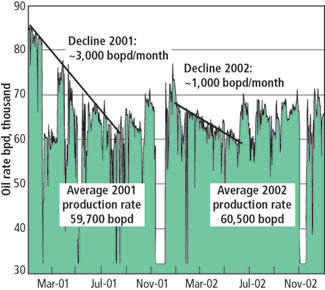 |
Fig. 1. Applying a real-time production management process, including its complementary people component, reversed a Harding field production decline.
|
|
The Harding production success was due in equal measure to successful infill drilling, improvements in operating efficiency and production optimization. The production optimization process relied on more effective use of monitoring information, enabling day-to-day reservoir management and continual operations optimization. Changes occurred not only in the traditional field operating processes and monitoring technologies, but, most importantly, with the people involved. People's activities and collaboration with vendors were amended to fit the chosen process and technology innovations.
ENHANCED MONITORING
From the onset, the Harding field development team knew that the wells would have very high productivities and low drawdowns, so permanent downhole gauges were chosen as the primary means of monitoring very small pressure changes required for managing well and reservoir performance. However, it was soon apparent that the full data value was not being used because of traditional production management process limitations, such as:
- Accuracy and performance of the downhole monitoring devices
- Traditional supervisory control and data acquisition (SCADA) systems that treat all data as process data, with no discrimination in the sampled frequency for different users in the asset
- Large data volumes that could not be properly managed, resulting in users spending more time manipulating than analyzing data and making collaborative decisions
- Different data views seen by offshore and onshore team members
- Long cycle time converting data into engineering applications used to optimize wells and process plants on an appropriate cycle.
A collaborative relationship evolved between the service company and the Harding team to address these limitations, with the service company providing the integrated technologies, and the asset team providing the reservoir/plant knowledge. Integration of the real-time production management components in the newly designed process is shown in Fig. 2.
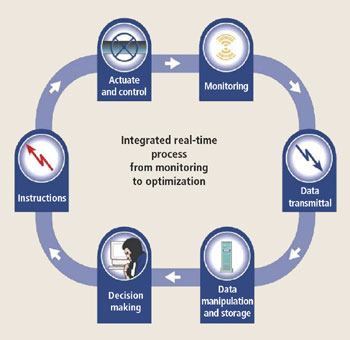 |
Fig. 2. Real-time production management process
implemented on Harding field asset follows this scheme.
|
|
In August 2000, a jointly developed, two-phase flow meter, capable of operating in horizontal wells and with excellent gas sensitivity, was installed in the PN1 well, which was drilled to evaluate the Harding North reservoir through an extended well test. The meter uses a conventional Venturi and a license-exempt radioactive source to measure the pressure drop and gamma ray attenuation from which mass flowrate and mixture density are computed. The Venturi also acts as a mixer, allowing a direct, accurate density measure that is independent of well deviation.
At Harding North, the meter enabled real-time well testing to characterize reservoir behavior and prove reserves. It also provided an accurate fluid properties description that facilitated design of an optimum field withdrawal strategy.
Production is through primary depletion, but the reservoir is pressure-supported by both a gas cap and a regional aquifer. The exact bubble-point of the reservoir fluid was unknown until the meter detected the onset of a gas cone, Fig. 3. This finding resulted in an eight day shut-in of the well, but also defined the future production strategy in which reservoir pressure is maintained at just above bubble-point by matching production off-take to reservoir influx. When this match occurs, bottomhole pressure, and hence downhole gauge pressure, are constant.
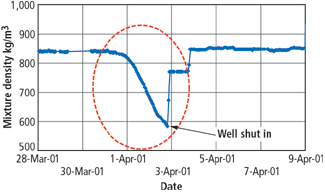 |
Fig. 3. Newly installed downhole flow meter in Harding North PN1 well was able to detect a gas cone.
|
|
In the case of overproduction, the downhole gauge pressure slowly decreases, which is then spotted by the onshore and offshore teams and corrected by choking back the well. Since onset of the gas cone, gas production has remained at solution gas/oil ratio (GOR) and the watercut has slowly developed. Careful operating practices have delayed significant water breakthrough.
REAL-TIME DATA MONITORING AND DELIVERY
Experiences gained with the flow meter accelerated the next step in the process, which was installation of a real-time production data delivery system capable of trending and intelligent alarms. Since the users were in multiple locations (offshore, onshore and service company offices), a secure and reliable means of information access by these users and the provision of a collaborative workspace were key requirements.
The data acquisition and management system (Fig. 4) installed is capable of securely transmitting real-time oilfield information from any site direct to a user's desktop. Information access is via a commercial Web browser, and secure two-way communication is possible to pass control actions to remote devices.
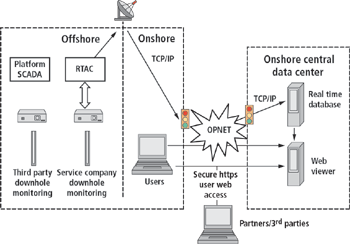 |
Fig. 4. Real-time data delivery architecture at Harding field follows this scheme.
|
|
A customizable, real-time acquisition and control (RTAC) unit installed on the Harding North platform functions as the heart of the system by managing downhole data acquisition and gathering. In addition, this unit can be configured to interface to third-party devices and/or SCADA units using standard communications protocols such as Modbus or OLE for process control (OPC). The unit is installed on the operator's network and data are transferred via secure TCP/IP and a dedicated subscription-leased line (oil partner network, also called OPNET) to a central database within the service provider's regional data services center.
Use of a regional data services center, which is shared among different operators, significantly reduces costs as compared to use of a dedicated real-time infrastructure. The data are compressed for efficiency and automatic-link recovery is available in the event of a telecommunications break. Data are updated every 3–6 sec and managed such that each user can view the data using predefined or customizable trends. The system is engineered for maximum security and flexibility as follows.
- Access to the data is either via secure https access, or the dedicated OPNET leased line.
- An administrator in the operator's organization assigns different levels of information access to a diverse user base.
- A configured permissions structure provides an additional level of security for supervisory control commands.
REAL-TIME WORKFLOW BENEFITS
By allowing authorized personnel, both onshore and offshore, access to the same project information through an online Internet workspace, the enhanced data acquisition/monitoring/delivery system has promoted teamwork and collaboration in the daily and weekly production decision-making processes. The Harding team also is able to view both downhole information and topsides data simultaneously. This feature allows the onshore support team to monitor reservoir performance to within a fraction of a psi. The effect of daily changes made to each well can then be assessed and modified as appropriate.
Thus, Harding reservoir performance is optimized to within 1-psi resolution, which is important, as well productivities are very high and each well's performance is very sensitive to small pressure changes. The productivity index is from 300 bopd/psi to 700 bopd/psi. The Central and North reservoirs have been deliberately operated at 1 psi above bubble point for 18 months.
Better use of downhole data has enabled precise reservoir management through optimal well performance and opened up new windows of opportunity for further reservoir management improvements. Because the effect of even very small increases in reservoir pressure can be monitored and understood, the true value of pressure support and voidage maintenance can be better quantified.
For example, enhanced reservoir understanding allowed the sanction of an alternative water-injection project during platform turnaround. One of Harding's aquifer wells on electrical submersible pump lift was connected directly to the field's three water injectors. Exactly as predicted, the extra 814,000 bbl injected over two weeks raised reservoir pressure by 5 psi. The effects of the water injection could be seen in real time (Fig. 5) from the gauge data as the turnaround progressed—indeed, the first visible rise in reservoir pressure came just 20 min after injection began. This increased reservoir pressure will reduce the gas cones in several key wells, increasing dry oil production by 4,000 bopd.
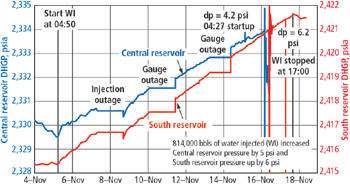 |
Fig. 5. Water injection effects are now monitored in real time at Harding field.
|
|
FUTURE DEVELOPMENT: REAL-TIME GAS LIFT OPTIMIZATION
With the downhole and topsides information readily available, quality controlled and managed, the next step is an automated gas-lift optimization system. This will be run as a pilot with the goal of optimizing well production against changing topsides constraints, such as handling produced water and gas compression capacity.
The optimization process consists of an automated system in which real-time production data is fed and matched against well models supplied by Harding. An optimization algorithm connects to the well models and is able to identify the optimum distribution of gas lift after taking into account a number of constraints. The results will then be validated by an artificial lift specialist and posted as daily recommendations on the Internet Web site, where the asset team can view results and plan daily operations.
OUTLOOK
The real-time production optimization system installed and in use at Harding field, UK North Sea, is being used collaboratively by onshore and offshore team members, as well as authorized service providers, to enhance production operations and manage the reservoir in ways not previously possible.
This field installation illustrates how a real-time data acquisition and control system can securely communicate with a remote data management system to achieve streaming of high-quality data from existing and new downhole monitoring devices, allowing event notification and remote advice for the control of wellsite functions. The installation described is based on emerging information technologies for secure data transmission and bidirectional communication. In this way, systems can be quickly deployed at the wellsite using only standard physical communication links (fiber, satellite, cellular, Internet, etc.), making them independent of communication service and legacy infrastructure. The data can then be securely accessed and downloaded by multiple users via standard desktop personal computer (PC) Web browsers over their intranets or the Internet, and it provides a collaborative workspace.
As use of the system progresses, applications in addition to those described here are sure to be found. Still in its early stages, the system already delivered significant production results in 2002. 
ACKNOWLEDGMENTS
The authors thank the management of BP Exploration and Production UK Ltd., Kerr-McGee North Sea Ltd. and Schlumberger for permission to publish this article, which was written from SPE Paper 83973, first presented at Offshore Europe 2003, held in Aberdeen, UK, September 2–5, 2003.
THE AUTHORS
|
| |
Simon Richardson is field development manager for BP's Wytch Farm oil field, England. Previously, he was subsurface team leader for Harding field. Richardson has 20 years of experience as a reservoir engineer with Shell, Britoil and BP Exploration. He has authored several SPE papers on reservoir management and has a degree in engineering science from Oxford University.
|
|
Helen Keron has a degree in engineering and materials science from Oxford University. She is a wells engineer within BP's Mature Business Unit Well Services team in the North Sea. Before that, she was the production engineer for Harding field. Keron has five years of experience as a petroleum engineer with BP in the North Sea.
|
| |
Wahyu Jatmiko has a degree in chemical engineering from Gadjah Mada University. He joined BP Indonesia in 1992 and has been assigned work in both petroleum and reservoir engineering disciplines. During 2002-2003, he worked on Harding field as surveillance engineer. Currently, he is a petroleum engineer for BP Indonesia, largely focused on gas lift optimization in BP's West Java field.
|
|
Jack Booker is an acquisition-data delivery engineering manager for Schlumberger, based in the Riboud Product Center, Clamart, France. He manages a team that develops acquisition, control and data transmission systems for wellsite sensor and downhole control tools. He received an MSc degree in electrical and computer engineering from the University of Texas, Austin. He is a member of IEEE and SPE.
|
|
Leo Osugo has worked for Schlumberger internationally for 20 years. He started in Wireline & Testing as a field engineer working his way through several successively senior positions in operations, manufacturing, marketing and sales. His present position is real-time production management business development manager for the UK.
|
|
John M. Donachie is a business development manager for Schlumberger, focused on Framo multiphase pumps and metering applications. He previously focused on production lift, metering and optimization engineering. He received a BA degree in mechanical engineering from the University of Aberdeen in 1995 and is an active member of the SPE, particularly its young oil and gas professional forums.
|
|







